
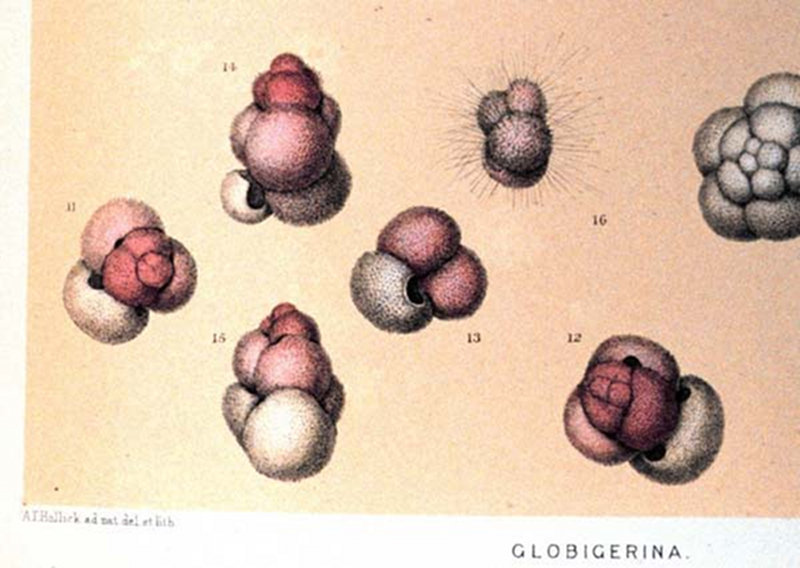
Speciments of Globigerina. Source: The Voyage of H.M.S. Challenger Zoology, Vol. IX. Plate LXXIX.) (Courtesy of NOAA Library.) Image courtesy of NOAA Photo Library Download image (jpg, 87 KB).
A key purpose of NOAA’s Ocean Exploration Initiative is to investigate the more than 95 percent of Earth’s underwater world that until now has remained virtually unknown and unseen. Such exploration may reveal clues to the origin of life on earth, cures for human diseases, answers on how to achieve sustainable use of resources, links to our maritime history, and information to protect endangered species.
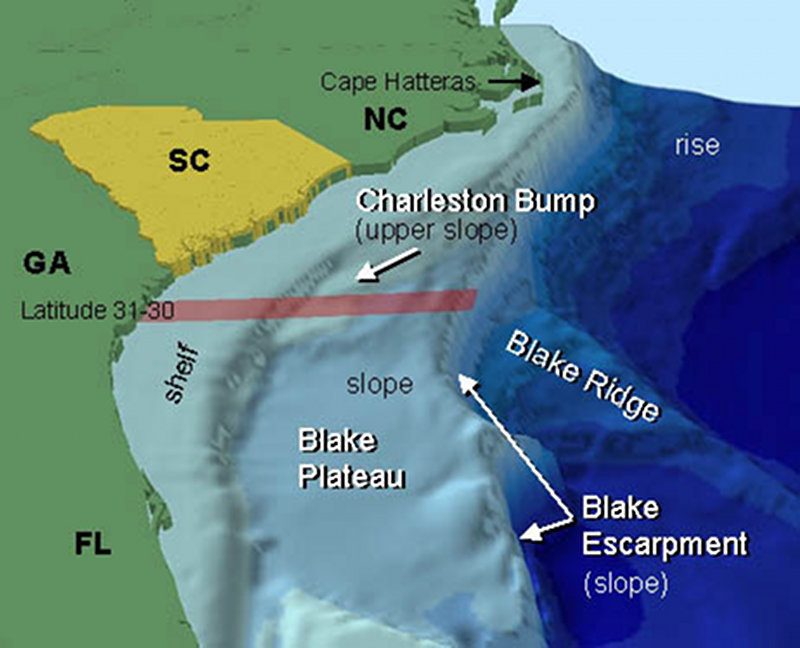
The continental margin off Cape Hatteras, North Carolina, is a classic shelf-slope-rise sequence, while most of the southeast U.S. continental margin is terrace-like, with prominent features such as the Blake Plateau, Blake Ridge, and Blake Escarpment, as well as the Charleston Bump. The Latitude 31-30 Transect is indicated by the red area. Image courtesy of the Estuary to the Abyss 2004 Expedition. Download image (jpg, 83 KB).
At least 660 submarine canyons are known throughout Earth’s ocean, and recent studies (De Leo, et al., 2010) suggest that at least some of these may be among the most productive habitats that have been found in the deep sea. Canyons can enhance biological productivity by providing varied and complex habitats, and by concentrating organic material and nutrient-rich sediments that provide food resources in areas that are normally food-poor. These resources can support large biomasses of benthic (bottom-dwelling) invertebrates that in turn provide food for a wide variety of bottom-feeding fishes, crustaceans, and other megafauna (the prefixes mega-, macro-, and so forth do not have precise meanings, and researchers often provide their own definitions; typically, megafauna are larger than about 20 mm; macrofauna are in the range 0.5 mm – 20 mm; meiofauna are 0.05 – 0.5 mm; and microfauna are less than 0.05 mm). In addition to unusually high biomass, Hawaiian submarine canyons have been found to have a high biodiversity, including many species that are not found in any other habitats (Vetter, Smith and De Leo, 2010). This suggests that Hawaiian submarine canyons contain a substantial specialized fauna that would not exist in the archipelago if canyons were not present.
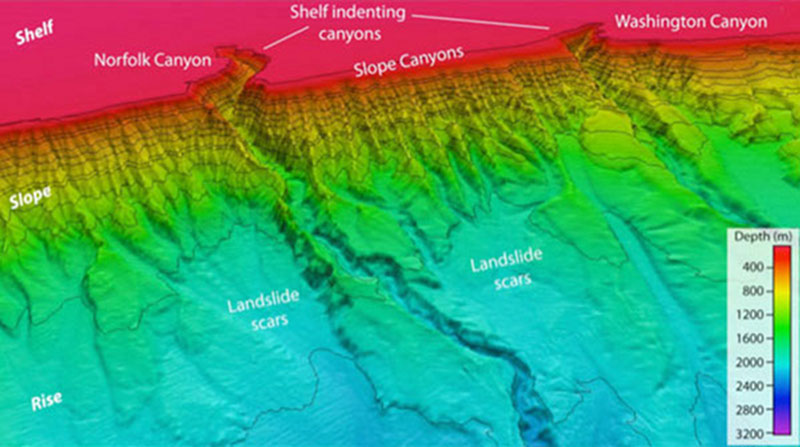
Canyons along the continental margin offshore of Virginia. Image courtesy of USGS. Download image (jpg, 82 KB).
Mid-Atlantic canyons may also include chemosynthetic communities whose food webs are based on the energy of chemical compounds, in contrast to photosynthetic communities whose food webs are based on photosynthesis that uses energy from the sun. The first chemosynthetic communities were discovered in 1977 near the Galapagos Islands in the vicinity of underwater volcanic hot springs called hydrothermal vents, which usually occur along ridges separating the Earth’s tectonic plates. Hydrogen sulfide is abundant in the water erupting from hydrothermal vents, and is used by chemosynthetic bacteria that are the base of the vent community food web. Another type of chemosynthetic community is found in areas where gases (such as methane) and liquid hydrocarbons seep out of sediments. These areas, known as cold seeps, are commonly found along continental margins, and (like hydrothermal vents) are home to many species of organisms that have not been found anywhere else on Earth.
Deepwater canyons are among the most striking features of the continental slope off the east coast of the United States. There are more than 70 of these canyons in depths ranging from about 100 m to about 3,500 m, with steep, narrow walls that make exploration difficult. Research during the 1970’s and 1980’s (Hecker et al., 1980; Hecker and Blechschmidt, 1979) showed that submarine canyons along the mid-Atlantic continental slope can contain unique hard bottom communities, many of which include high densities of deepwater corals. In addition, there are numerous shipwrecks in the same area that are not well-documented and whose historical and ecological significance are presently unknown. Similar sites in other areas are known to support important fisheries and other biological resources, but also to be vulnerable to severe damage from human activity and natural events. In addition, cold-seep communities have been found at two locations on the east coast continental slope. These communities may signal the presence of other unusual ecosystems, potentially important energy resources and areas that may be susceptible to submarine landslides that can trigger tsunamis. A recent assessment of tsunami hazard along the U.S. east coast (ten Brink, 2009) by the U.S. Geological Survey with funding from the U.S. Nuclear Regulatory Commission, has identified submarine landslides along the submerged continental margin as the primary potential source of dangerous tsunamis to this coast. An historic example of this hazard was the 1929 Grand Banks submarine landslide, which produced a tsunami 3 to 8 m high. That tsunami killed 28 people along the Newfoundland coast, even though this area was sparsely populated at the time. A similar tsunami along the present-day Atlantic coast might be much more devastating.
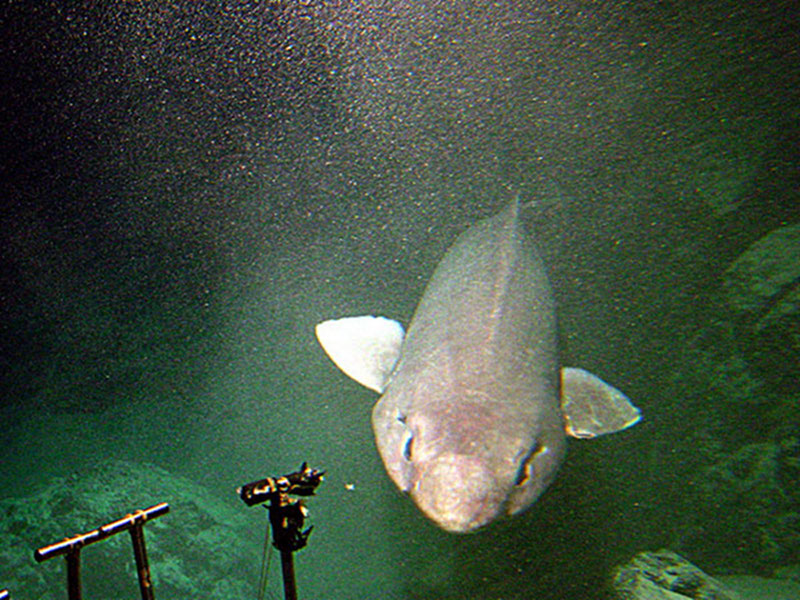
This 3-m-long false cat shark (Pseudotriakis acrages) was observed in Nihoa Canyon at 1,200 m depth. Image courtesy of the Northwest Hawaiian Islands 2003 Expedition. Download image (jpg, 166 KB).
Habitat complexity in submarine canyons results from a combination of geological and biological features. Steep canyon walls, rocky outcrops, hard clay formations, boulders, rock rubble, and soft sediments all provide surfaces upon and within which various benthic organisms may grow. Sessile (non-moving) species such as sponges and cnidarians increase the surface complexity and provide additional habitat for other species. Soft sediment is the major substrate type, and most mid-Atlantic canyons have extensive holes and tunnels produced by crabs, tilefish, burrowing anemones, and other animals that further extend the range of available habitats.

Just a few decades ago, submersibles and remote sensing technologies allowed scientists to visit the farthest reaches of the ocean for the very first time. Of the many wonders they discovered, one of the most surprising was the existence of rich clusters of life flourishing in the darkness of the deep sea floor. Download image (jpg, 76 KB).
Methane is produced in many environments by a group of Archaea that obtain energy by anaerobic metabolism through which they break down the organic material contained in once-living plants and animals. When this process takes place in deep ocean sediments, methane molecules are surrounded by water molecules, and conditions of low temperature and high pressure allow stable ice-like methane hydrates to form. Methane hydrate is a type of clathrate, a chemical substance in which the molecules of one material (water, in this case) form an open lattice that encloses molecules of another material (methane) without actually forming chemical bonds between the two materials. Scientists are interested in methane hydrates for a variety of reasons, including their potential as an energy source, their association with unusual biological communities, and their possible role in tsunamis and climate change (see “More About Methane Hydrates“, below).
In 1995, Ocean Drilling Program Leg 164 documented extensive deposits of methane hydrates and methane gas on the Blake Ridge, on the continental slope off the coast of South Carolina and Georgia. The Ocean Explorer 2001 Deep East expedition found methane gas in water samples collected in the Hudson Canyon region, as well as extensive cold- seep communities on the Blake Ridge that contained some of the largest seep organisms ever discovered. To date, only one cold seep has been discovered in the target area for the Deepwater Canyons 2012 - Pathways to the Abyss expedition; but considering that very little of this area has been explored at all, the discovery of even one cold seep suggests that there may be others.
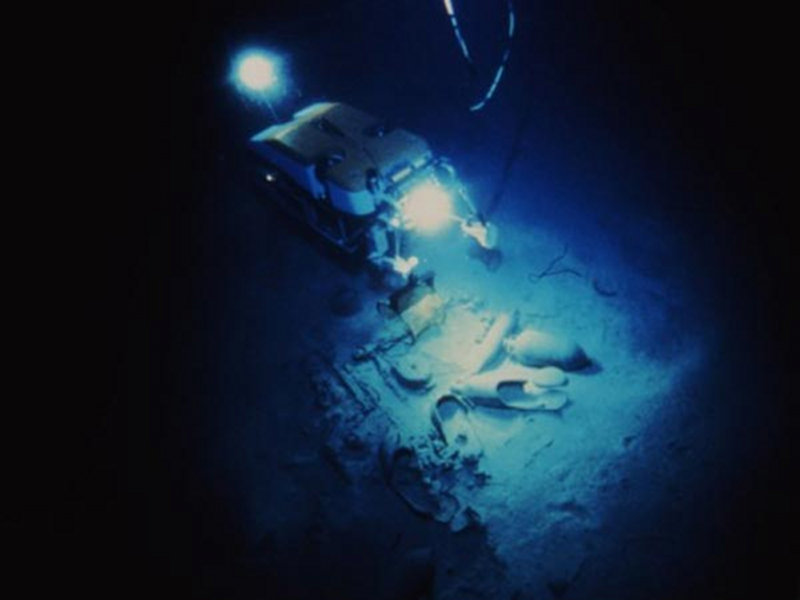
Advanced robotic technologies have been used to study shipwrecks and other underwater archaeological sites for many years. Robotic vehicles can map and photomosaic a shipwreck with quantifiable accuracy in the space of a few hours, and enable access to sites resting on the other 98% of the seafloor. Image courtesy of Woods Hole Oceanographic Institution, copyright Quest Group Ltd. Download image (jpg, 45 KB).
Shipwrecks are yet another type of substrate known to be present in mid-Atlantic canyons, and have historical as well as ecological significance. The mid-Atlantic coast of the United States has a maritime history that spans more than 400 years, and is marked by numerous shipwrecks that are neither well-documented nor well-understood. One of the most famous is the former German battleship Ostfriesland, which sank on July 21, 1921 as a result of bombs dropped from airplanes under the command of Brigadier General William “Billy“ Mitchell who wanted to demonstrate the potential for aircraft to destroy naval warships. Eight more German warships and submarines soon followed the Ostfriesland to the bottom after serving as targets for aerial attack practice. Collectively, these vessels are now known as the “Billy Mitchell Fleet.“
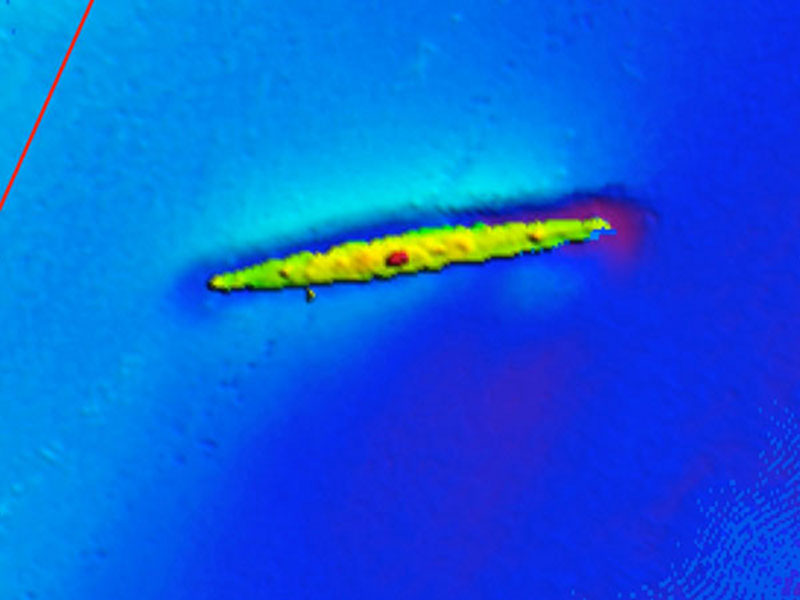
High resolution multibeam sonar image of a shipwreck on the continental shelf near Norfolk Canyon. Image courtesy of R Mather, URI. Download image (jpg, 48 KB).
Shipwrecks, like many other human artifacts, can provide hard surfaces that may be associated with a high biomass of biologically diverse organisms. Deterioration of shipwrecks can enhance the settlement of some organisms (e.g., corals; see “Corrosion to Corals.“), but the importance of artificial substrates to natural ecosystems is not clear. In areas with a low percentage of natural hard substrates (such as mid-Atlantic submarine canyons), shipwrecks may represent a significant habitat resource for benthic organisms.
Because of the historical significance of many shipwrecks, selection of wrecks for investigation by the Deepwater Canyons 2012 - Pathways to the Abyss expedition will be guided by criteria for evaluating the eligibility of historic properties to the National Register of Historic Places. These criteria emphasize associations between the property and significant events, persons, types of property, and patterns in history. Sites representing certain vessel types (warships, submarines, freighters, fishing boats) and historic periods (World War II, early 1920s) that have influenced the submerged cultural landscape of the study area will be targeted for investigation.
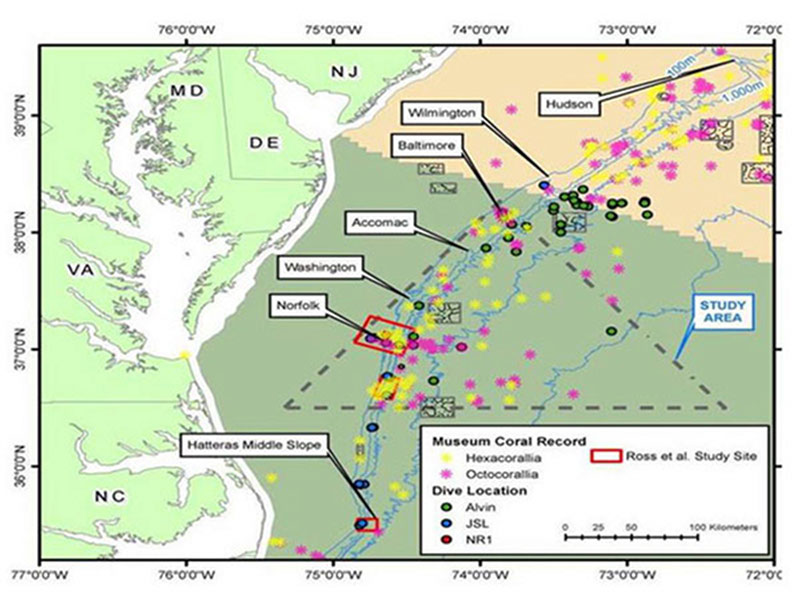
The primary target areas for the Deepwater Mid-Atlantic Canyons Project are in and around the Norfolk, Washington, Accomac, and Baltimore canyons. are This map shows places where deep-sea corals were previously identified (indicated by yellow and pink stars) as well as locations of previous submersible dives (green, blue, and red circles). Image courtesy of W Ross, UNC-W. Download image (jpg, 100 KB).
The purpose of the Deepwater Canyons 2012 - Pathways to the Abyss expedition is to explore and investigate deepwater coral and hard bottom communities and shipwreck sites on the continental slope off Virginia, Maryland, and Delaware. These studies are expected to discover new coral areas and other significant canyon habitats and provide information about processes that control their distribution, abundance, and ecological functions. Selected shipwreck sites will be studied to determine their historical significance and their ecological function as artificial substrates for deepwater organisms.
The target area for this study includes three major submarine canyon areas: Norfolk, Washington and Baltimore Canyons, located between 36.5 – 38.5 North latitude, and 72.0 – 75.5 W longitude. A minor canyon area located between Washington and Baltimore Canyons known as Accomac or Poor Man’s Canyon is also included in the target area.
Expedition Questions
Key questions for the Deepwater Canyons 2012 - Pathways to the Abyss expedition involve benthic ecology, taxonomy, food webs, paleoecology, geology, physical oceanography, and marine archaeology. These questions include:
Exploration Technology
To answer these questions, the Deepwater Canyons 2012 - Pathways to the Abyss expedition will:
Many of these activities will be part of a series of surveys using the Kraken 2 remotely operated vehicle (ROV; underwater robot). At each canyon, most ROV dives will emphasize bottom transecting, collecting and photographing specimens on or near the bottom. Actual placement of these transects will be based on analysis of new and existing multibeam sonar data and other historical data, and will cover a variety of habitat categories. Biological specimens and sediment samples may be collected at any time after the ROV lands on the sea floor. Standardized video transects will be done whenever the ROV moves from one location to another. Transects will be of variable lengths and some may be quite long to cover wide ranges of habitat. Video transects will be taken on every dive since these are the primary means of visual habitat characterization. Transects are designed to run across all habitat types, including reef and non-reef areas. Digital still photography and video recording will be conducted throughout the dives. All collections will be documented with video. Traps for some fauna may be deployed during some dives, and may be left on site until they are retrieved during later dives.
Additional mapping and video data collection will be done in the vicinity of shipwrecks, including some that are part of the “Billy Mitchell Fleet“. The primary tool for on-site investigations will be the ROV. An overall visual inspection of each site will establish the extent and nature of the wreckage, key features that may provide identification and other information, and the extent of previous human visits to the site. This visual inspection will allow project archaeologists and biologists to make decisions about additional site survey and mapping. In all cases, detailed mapping will be required. The ROV will systematically survey each site with a series of transects arranged to that they provide overlapping images of the entire site. If important features or artifacts are observed during these surveys, the ROV may hover over these objects and obtain more detailed images and location data before resuming the survey. Archaeologists participating in the project will also compile a catalog of existing historical data relevant to the survey area, and review these data for information about cultural material that may be present in the study area.
Sonar (which is short for SOund NAvigation and Ranging) systems are used to determine water depth, as well as to locate and identify underwater objects. In use, an acoustic signal or pulse of sound is transmitted into the water by a sort of underwater speaker known as a transducer. The transducer may be mounted on the hull of a ship, or may be towed in a container called a towfish. If the seafloor or other object is in the path of the sound pulse, the sound bounces off the object and returns an “echo“ to the sonar transducer. The system measures the strength of the signal and the time elapsed between the emission of the sound pulse and the reception of the echo. This information is used to calculate the distance of the object, and an experienced operator can use the strength of the echo to make inferences about some of the object’s characteristics. Hard objects, for example, produce stronger echoes that softer objects. This is a general description of “active sonar“. “Passive sonar“ systems do not transmit sound pulses. Instead, they “listen“ to sounds emitted from marine animals, ships, and other sources.
Multibeam sonar is used to make accurate bathymetric maps. A multibeam system uses multiple transducers pointing at different angles on either side of a ship to create a swath of signals. The time interval between signal transmission and return echo arrival is used to estimate depth over the area of the swath. In some systems, the intensity of the return echo is also used to infer bottom characteristics that can be used for habitat mapping. The Deepwater Canyons 2012 - Pathways to the Abyss expedition will use a Simrad EM1002 multibeam system. Visit Ocean Explorer Technology for more information about sonar systems.
A key technology for the Deepwater Canyons 2012 - Pathways to the Abyss expedition is the Kraken 2 remotely operated vehicle (ROV), a tethered robot capable of diving and sampling to depths of 1,000 meters. The Kraken 2 ROV was developed at the University of Connecticut’s Northeast Underwater Research Technology and Education Center to provide a broad range of sampling, sensing and imaging capabilities. When deployed, an electro-optic tether (a cable containing fiber optic and wire conductors) connects the ROV to a control van aboard the support ship. Imaging equipment includes digital still, and HD cameras, a strobe light for still photography, and high intensity LED and HMI (hydrargyrum medium-arc iodide) lights for video. Sampling equipment includes a suction sampler, biobox (a container that holds living specimens in water to protect them from thermal shock), and a manipulator arm.
Underwater robots have several important advantages when compared to human occupied submersible vehicles:
Regardless of their shape or size, underwater robots include several basic systems:
Some ROVs also include navigation equipment that can precisely locate the robot’s geographic position. Ordinary GPS equipment will not work for this because satellite signals do not penetrate very far into the ocean. Instead, acoustic devices called short baseline or ultra-short baseline positioning equipment are used to determine the ROVs position relative to the surface ship. These devices are based on the same principles as sonar, and can be combined with GPS data from the surface ship to accurately determine an ROV’s position underwater.
For more information about ROVs, visit Ocean Explorer Technology.
Long-term measurements of physical and chemical environmental characteristics will be made with a combination of benthic landers and moorings installed at both ends of the canyons to be studied, as well as other areas of particular interest (such as seeps and hard substrates). These devices are typically left in place for at least a year, so that seasonal variations in parameters can be detected.
Moorings typically consist of several floats capable of withstanding deep-ocean pressures, a steel cable, and a heavy weight. Instruments to make desired measurements are attached to the cable. Often several sets of instruments are attached at different locations along the cable so that data can be recorded at different depths or distances from the bottom.
Benthic landers are instrument-carrying platforms that are placed on the seafloor to record data, often over an extended period of time. Typically, these platforms consist of a metal frame, floatation, and a ballast weight to keep the platform oriented in the desired position. The weight is attached to the platform with an acoustic release device that will release the weight and allow the platform to surface when an appropriate acoustic signal is received from scientists aboard a surface ship. If an acoustic release system is installed, the platform will also carry signaling devices such as a radio beacon, strobe light, or large flag to help scientists locate the benthic lander after it reaches the ocean surface.
Benthic landers for the Deepwater Canyons 2012 - Pathways to the Abyss expedition will carry instruments to measure currents, temperature, salinity, turbidity, dissolved oxygen, fluorescence, and suspended sediment, as well as data loggers to record measurements made by these instruments. In addition, landers will carry biological experiments, such as plates of various materials to investigate larval settlement. Some landers also may have video and/or digital still cameras and acoustic Doppler current profilers to measure currents in the water column. Moorings will carry sediment traps, current meters, and temperature data loggers. For more information about benthic landers, visit the Lophelia Benthic Landers site.
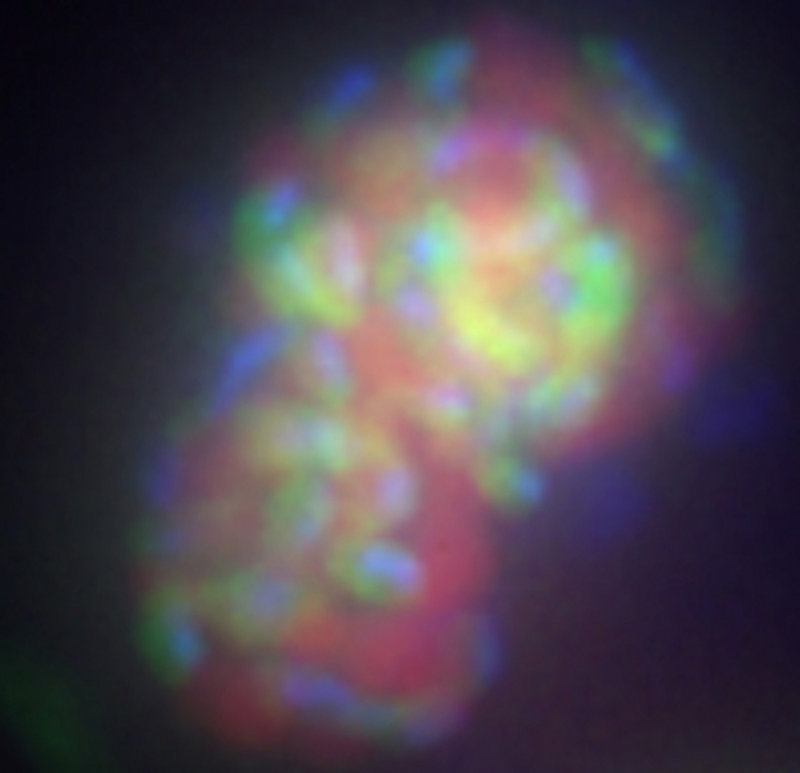
A cluster of anaerobic methane-consuming archaea (red) and sulfate-reducing bacteria (gree). This cluster of cells has been labeled with two ribosomal rRNA probes that target these two specific groups and have fluorescent molecules attached that show up as different colors when viewed with a special microscope. Image courtesy of Victoria Orphan, California Institute of Technology. Download image (jpg, 49 KB).
Methane hydrates appear to be ordinary ice, but clearly are different since touching a match to one of these ices causes it to catch on fire. Scientists are interested in methane hydrates for several reasons. A major interest is the possibility of methane hydrates as an energy source. The U.S. Geological Survey has estimated that on a global scale, methane hydrates may contain roughly twice the carbon contained in all reserves of coal, oil, and conventional natural gas combined. In addition to their potential importance as an energy source, scientists have found that methane hydrates are associated with unusual and possibly unique biological communities that may be sources of beneficial pharmaceutical materials.
While such potential benefits are exciting, methane hydrates may also cause big problems. Although methane hydrates remain stable in deep-sea sediments for long periods of time, as the sediments become deeper and deeper they are heated by the Earth’s core. Eventually, temperature within the sediments rises to a point at which the clathrates are no longer stable and free methane gas is released (at a water depth of 2 km, this point is reached at a sediment depth of about 500 m). The pressurized gas remains trapped beneath hundreds of meters of sediments that are cemented together by still-frozen methane hydrates. If the overlying sediments are disrupted by an earthquake or underwater landslide, the pressurized methane can escape suddenly, producing a violent underwater explosion that may result in disastrous tsunamis.
The release of large quantities of methane gas can have other consequences as well. Methane is one of a group of the so-called “greenhouse gases.“ In the atmosphere, these gases allow solar radiation to pass through to the surface of the Earth, but absorb heat radiation that is reflected back from the Earth’s surface, thus warming the atmosphere. Many scientists have suggested that increased carbon dioxide in the atmosphere produced by burning fossil fuels is causing a “greenhouse effect“ that is gradually warming the atmosphere and the Earth’s surface. A sudden release of methane from deep-sea sediments could have a similar effect, since methane has more than 30 times the heat-trapping ability of carbon dioxide. In 1995, Australian paleoceanographer Gerald Dickens suggested that a sudden release of methane from submarine sediments during the Paleocene Epoch (at the end of the Tertiary Period, about 55 million years ago) caused a greenhouse effect that raised the temperatures in the deep ocean by about 6° C. The result was the extinction of many deep-sea organisms known as the Paleocene extinction event. More recently, other scientists have suggested that similar events could have contributed to mass extinctions during the Jurassic Period (183 million years ago), as well as to the sudden appearance of many new animal phyla during the Cambrian Period (the “Cambrian explosion, about 520 million years ago). The Cape Fear slide, the largest submarine slide on the U.S. East Coast, occurred approximately 20,000 years ago and may have been related to methane hydrates and sudden release of methane gas. The timing of the Cape Fear slide also roughly coincides with the end of the last major glaciation.
For more information, please contact the NOAA Office of Ocean Exploration and Research Education Team at: oceanexeducation@noaa.gov.